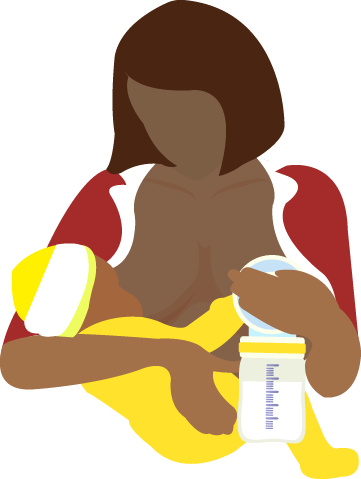Jaundice, a sign of elevated bilirubin levels, is common during the first weeks of life, especially among preterm newborns. Bilirubin, a product from the normal breakdown of red blood cells, is elevated in newborns for several reasons:
- Newborns have a higher rate of bilirubin production due to the shorter lifespan of red blood cells and higher red blood cell concentration compared to adults.
- Newborns have immature liver function, leading to slower metabolism of bilirubin.
- Newborns may have a delay in passage of meconium, leading to increased reabsorption of bilirubin in the intestines.
- In most newborns, jaundice is termed “physiologic jaundice” and is considered harmless.
What is the difference between suboptimal intake jaundice and breast milk jaundice?
Suboptimal intake jaundice, also called breastfeeding jaundice, most often occurs in the first week of life when breastfeeding is being established. Newborns may not receive optimal milk intake, which leads to elevated bilirubin levels due to increased reabsorption of bilirubin in the intestines. Inadequate milk intake also delays the passage of meconium, which contains large amounts of bilirubin that is then transferred into the infant’s circulation. In most cases breastfeeding can, and should, continue. More feedings can reduce the risk of jaundice.
Breast milk jaundice most often occurs in the second or later weeks of life and can continue for several weeks. While the exact mechanism leading to breast milk jaundice is unknown, it is believed that substances in the mother’s milk inhibit the ability of the infant’s liver to process bilirubin.
Phototherapy is a common treatment for jaundice. Other therapeutic options include temporary supplementation with donor human milk or infant formula, and rarely, temporary interruption of breastfeeding.Top of Page
Should a mother continue breastfeeding if her child has jaundice?
Usually. Most newborns with jaundice can continue breastfeeding. More frequent breastfeeding can improve the mother’s milk supply and, in turn, improve caloric intake and hydration of the infant, thus reducing the elevated bilirubin. In rare cases, some infants may benefit from a time-limited, temporary interruption (12-48 hours1,2) of breastfeeding with replacement feeding to help aid in the diagnosis of breast milk jaundice. Ongoing clinical assessment, including repeat bilirubin levels, will help determine when breastfeeding can resume. Further guidance is outlined in the Academy of Breastfeeding Medicine’s clinical protocols on supplementationexternal icon and jaundiceexternal icon. If temporary breastfeeding interruption is required, it is critical to help mothers maintain their milk production during this time.
Sources: CDC
- Wambach, K. & Riordan, J. (2015). Breastfeeding and Human Lactation (5th ed.). Jones & Bartlett Learning. Page 405.
- Lawrence, R.A & Lawrence, R.M. (2016). Breastfeeding: A Guide for the Medical Profession (8th ed.). Philadelphia, PA: Elsevier. Page 506.




